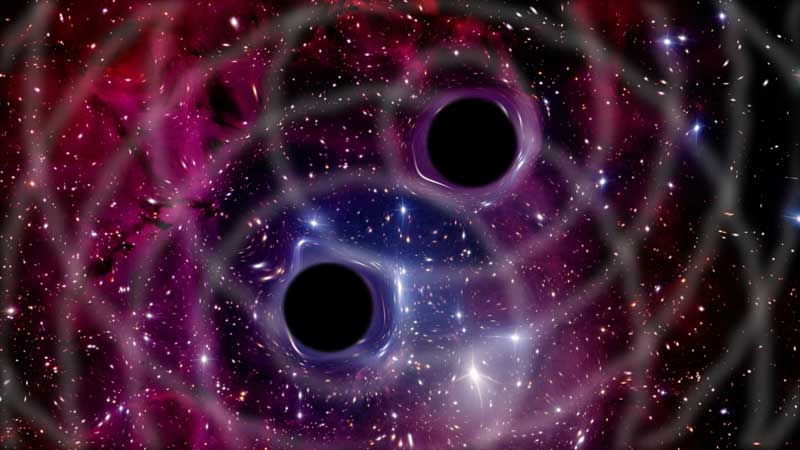by Rachel Kaufman
 When scientists working with the Laser Interferometer Gravitational-Wave Observatory (LIGO) announced in February that the observatory had detected gravitational waves for the first time, physicists around the world were thrilled, 1perhaps none more so than Patrick Brady, who has spent the last twenty years of his life working on LIGO, now as an executive committee member of the LIGO Scientific Collaboration.
When scientists working with the Laser Interferometer Gravitational-Wave Observatory (LIGO) announced in February that the observatory had detected gravitational waves for the first time, physicists around the world were thrilled, 1perhaps none more so than Patrick Brady, who has spent the last twenty years of his life working on LIGO, now as an executive committee member of the LIGO Scientific Collaboration.
For Brady, who has been fascinated by black holes since childhood, LIGO's success was a triumph.
"We knew there was something in the data very soon afterwards. I woke up in the morning after the event—it was about three hours after the wave had passed the earth," Brady says. "I was grinning from ear to ear, and wondering to myself, 'Why am I grinning from ear to ear?' And then I was like, 'Yeah, this is a pair of black holes that collided a billion years ago in the universe.'"
And now the real work begins.
-----
Brady was born in Dublin and took to math and physics early on. "Black holes were a big hit," he says.
After getting both his bachelor’s and master’s at the University College Dublin, he moved to Canada to study under cosmologist Werner Israel.
"We worked on some very esoteric concepts about black holes, [things] that will never be observed," Brady says. It sounds like sci-fi, but essentially they were trying to determine whether black holes really were wormholes to other universes. "This is a fascinating idea," Brady says, “but ultimately one that, at least for now, can only be theorized about.”
"Someday we'll go back to studying it again—for now I'm focused on something that can be [measured.]"
Following the completion of his PhD, Brady went to the California Institute of Technology as a postdoc in 1995. After years of uncertainty, LIGO had finally been funded but not yet built.
"To some extent I didn't realize how early on it was." But he agreed to stay and work on the project. Brady's role was to help learn how to use LIGO as a new tool.
"The interesting thing about LIGO as an astronomical observatory is that it’s a brand new tool. Nothing like it has ever been used to look at the universe before." It's not as simple as flipping a switch and getting results. People needed to "learn how to analyze the data, how to interpret the data...how to build the software that would take the data and use it to figure out if there was a gravitational wave present."
LIGO, the Laser Interferometer Gravitational-Wave Observatory, is an instrument originally proposed in the 1960s to detect gravitational waves by looking for slight variations in two laser beams that travel back and forth along 4 kilometer long arms, eventually recombining near their origin points. Any gravitational waves would change the length of the arms slightly, which would change the relationship to the two laser beams and create an interference pattern.
When Einstein first proposed the existence of gravitational waves in 1916, measuring them seemed like an impossible idea. "He said we'd never be able to do it," Brady says.
----

LIGO was finally turned on in the early 2000s, which was a long, arduous process.
"It wasn't just one day," Brady says. "The instruments are very complicated. But even in that initial LIGO phase when we went into our first science run, the first time that we felt the instruments were good enough to try to search for gravitational waves in a serious way, it was very exciting. I do remember how excited we were. We didn't see any gravitational waves, but still, we were pretty thrilled."
Yet it would be another decade and a half, and a series of improvements designed to enhance LIGO's sensitivity, before the observatory made the announcement that the instrument had detected gravitational waves from two black holes colliding.
The headlines all said that the detection vindicated Einstein's theories, which is true. But to Brady, the first detection is only "the first checkmark." He says that the point wasn't to prove Einstein correct but to see what physicists can now learn about the universe.
LIGO "is a tremendous new way to start to learn about what's going on in the universe… It really does open up to us a new sense, just like vision or sound.
"The truth of the matter is, we get to first of all answer the old question that was posed in 1916 by Einstein—are there gravitational waves? Absolutely, here you go. But now we get to ask a whole new set of questions about how the objects in the universe came to be, how they interact with each other, and how they change over time—new astronomy that we’re going to get to do over the next several years and decades."
- B. P. Abbott et al. (LIGO Scientific Collaboration and Virgo Collaboration), Observation of gravitational waves from a binary black hole merger, Phys. Rev. Lett. 116, 061102 (2016).